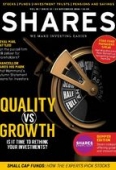Archived article
Please note that tax, investment, pension and ISA rules can change and the information and any views contained in this article may now be inaccurate.
Why are some ETFs priced so high?

Despite being billed as a cost-effective way to invest, the manner in which some exchange-traded funds (ETFs) are priced makes them prohibitive to all but the wealthiest individuals.
Some ETFs cost over £100 each
Many ETFs cost in excess of £100 for just one share, making it extremely difficult for smaller investors to try to build a diversified portfolio. This is leading some platforms to consider allowing investors hold small ‘portions’ of these products.
If you wanted to buy iShares FTSE 100 UCITS ETF (Acc) (CUKX) you’d have to shell out £96.94 to buy one share, for example. Similarly, iShares MSCI UK Large Cap UCITS ETF (CUKL) would cost you £108.28 for one share (as of 14 November).
Skewed allocation
Adam Laird, head of ETF strategy, Northern Europe at Lyxor, says this isn’t an issue for someone with a large lump sum to invest because the price and number of shares you receive is just arithmetic. It mainly becomes a problem when someone has small amounts to invest.
If you have £500 for a portfolio and the ETF you want to buy is priced at £100, your allocation to the ETF would be 20% of your portfolio, making it very concentrated. Problems also arise if you want to do regular dealing.
‘If you’re dripping a few hundred pounds a month into a portfolio, large share prices can make it difficult to invest precisely in the proportions you want,’ says Laird.
For those who invest via a model portfolio you could find yourself with a large allocation to cash and skewed asset weightings. If an ETF costs £80 and you have £100 to invest, you’d be left over with £20 sitting in cash. That’s why you often see minimum investment limits of £400 or more with ETF-led model portfolios.
Is there an industry rethink on pricing?
Unfortunately, the unit price of ETFs is unlikely to change because it is set at an institutional level where the participants are making trades worth millions of pounds each.
‘ETFs were created for institutions to move large amounts of money very quickly. It is a way for them to gain exposure to a large number of securities in one trade.
‘They don’t want dribs and drabs; they want one big block of shares because otherwise it would be unwieldy and inefficient,’ explains Mark Fitzgerald, head of product, Europe at Vanguard.
The US is more advanced than the UK in offering fractional dealing in ETFs
Fractional shares
It is down to the ‘secondary market’ – i.e. platforms selling ETFs to individual investors – to make ETFs more accessible. Over the past year, some platforms have begun developing the technology to enable people to buy ‘fractional’ shares – essentially a portion of an ETF rather than the whole share.
Fractional shares have existed in the US for some time and this year they arrived in the UK. A robo-advice platform launched fractional dealing in March 2016, allowing investors to hold small slices of shares in their portfolio. If an ETF is valued at £50, the robo-advice platform could buy half the share for £25 or a hundredth of the share for 50p.
In July, Winterflood Business Services, which provides dealing services to platforms, launched a fractional dealing service which allows the trading of ETFs to four decimal places. Platforms can adopt the solution and configure it onto their in-house systems for an annual fee.
In the financial adviser space, software platform Hubwise recently launched its own fractional dealing service.
These are positive developments, yet we don’t foresee mainstream DIY investment platforms offering fractional dealing in ETFs in the near term. It’s a wait and see situation.
Benefits of fractional dealing
Fractional dealing would be useful if you are low on cash or don’t want to spend a lot of money on a trade, but want exposure to an ETF that has a high price per share.
It would also enable you to invest all your available cash at once. For example, if you have £110 to invest and want to buy an ETF priced at £100, you’d be left over with £10 cash if fractional dealing isn’t available. If it is, you could buy 1.1 shares of the ETF in one trade, with no cash left sitting around.
Motif, a platform in the US which enables fractional dealing, is set up so that its customers don’t need to do any complicated maths when deciding how many fractional shares they can trade. They simply input the dollar amount for each trade and the platform figures out the rest.
The UK is streets behind the US and an industry-wide solution looks a long way off.
A forum was set up by the Tax Incentivised Savings Association to look into fractional trading, but ETF providers and share registrars weren’t able to come to an agreement on how to overcome the operational challenges, according to Dan Hughes, dealing and trade support manager at Ascentric, a platform for financial advisers.
At the moment, the decision to provide fractional shares sits with each individual investment platform. ‘The technology is now available, and it is down to the platforms to adopt it,’ says Joe Parkin, head of UK wealth and retail sales at iShares.
Important information:
These articles are provided by Shares magazine which is published by AJ Bell Media, a part of AJ Bell. Shares is not written by AJ Bell.
Shares is provided for your general information and use and is not a personal recommendation to invest. It is not intended to be relied upon by you in making or not making any investment decisions. The investments referred to in these articles will not be suitable for all investors. If in doubt please seek appropriate independent financial advice.
Investors acting on the information in these articles do so at their own risk and AJ Bell Media and its staff do not accept liability for losses suffered by investors as a result of their investment decisions.

 magazine
magazine








